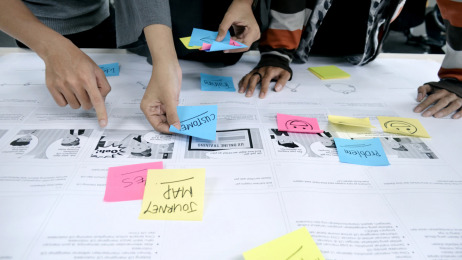
Kamil Tatol
-
Jan 23, 2023
-
3 min read
UX deliverables ensure that the design meets the users' needs and that the project stays on schedule and within budget. They can be used in various stages of the product design process and development and have different detail levels and completion levels.
What are UX deliverables?
UX deliverables are the tangible outputs of the UX design process. They are the documents, diagrams, and other artefacts that UX designers create to communicate their design solutions and ideas to stakeholders and the development team.
List of UX deliverables
There are many types of UX deliverables, and their usage depends on the project, team, and design process. Common UX deliverables include:
Research Artifacts
- User research reports
These documents sum up the results of user research studies, such as interviews, surveys, and usability testing. They give insights into the needs, goals, experiences, and pain points of the target audience, which inform the UX design decisions. - Personas
Personas are fictional characters that represent different product user types. They ensure that the UX design meets the needs of the target audience.
Information Architecture
- Sitemaps
These diagrams provide an overview of the structure and organisation of a product, i.e. a website or a mobile application. They help ensure that the information is easy to find and the navigation is intuitive. - User journey maps/User flows
These diagrams show a user's steps to complete a specific task within a product. They help UX designers understand the user journey and identify potential pain points or areas for improvement in UX design.
Wireframes
- Wireframes
These are low-fidelity visual representations of a product's user interface. They show a product's layout, content, and functionality, without the added visual design elements.
Prototypes
- Prototypes
These are functional models of a product that allow UX designers to test and validate their UX design solutions with users. They can range from simple clickable wireframes to highly interactive simulations of the final product.
Product design
- Design specifications
These are detailed descriptions of a product's visual design and functionality. They include visual elements of design, such as colours and typography, as well as technical specifications, such as screen sizes and interactions. - Style guides
These are documents that define a product's design language and standards. They specify the visual and typographical elements, tone of voice, and messaging that should be used throughout the product.
Key benefits of UX artefacts
UX deliverables are an essential part of the user experience design process, improving the following:
- Communication
UX deliverables help UX designers to communicate their ideas and UX design solutions to stakeholders and the development team. They provide a shared understanding of the product’s design process and help ensure everyone is on the same page throughout the project. - Collaboration
UX deliverables facilitate collaboration within the UX design team and with other stakeholders. They provide a common ground for discussion and feedback and allow UX designers to incorporate input and insights from multiple perspectives. - Validation
UX deliverables allow UX designers to validate their design solutions with users. By creating prototypes and conducting user and usability testing, designers can gather feedback and adjust the design before it is implemented. - Documentation
UX deliverables serve as a record of the UX design process and decisions. They provide a reference for the development team and can be used to maintain consistency and coherence in the final product.
In short, UX deliverables help UX designers communicate, collaborate, validate, and document their design solutions and are critical for creating successful and user-friendly products.
Who uses UX deliverables?
Various stakeholders use UX deliverables throughout a digital product's design process and development. Those stakeholders include:
- UX designers
UX designers are the ones who create and use UX deliverables as part of their design process to communicate their decisions and plans to the rest of the team.
Most used UX deliverables: wireframes, user research reports, personas, user journey maps, usability testing reports - Developers
Developers use UX deliverables to understand a website or application's visual and UX design and functionality requirements. UX deliverables actually guide their development work.
Most used UX deliverables: design specifications, wireframes, prototypes - Project managers
Project managers use UX deliverables to track the progress of a project and ensure that it stays on schedule and within budget.
Most used UX deliverables: project timelines, budget plans, wireframes, prototypes, usability testing reports - Clients
Clients use UX deliverables to understand the UX design decisions and validate the user experience. They help them confirm that the final product will meet their users’ needs.
Most used UX deliverables: wireframes, prototypes, and usability testing reports
In other words, many stakeholders are using UX deliverables as they help them understand the design decisions and requirements, provide feedback and ensure that the UX design meets the needs of the target audience while the project stays on schedule and within budget.
How to choose adequate deliverables?
If you’re facing the challenge of choosing the appropriate UX deliverables for your project, we have some helpful tips to take into account while making your choice.
1. Understand your project's goals and objectives.
Before you move on to choosing appropriate UX deliverables, make sure you understand the project’s goals and objectives and how they align with your users’ needs. Once you have those insights, identifying key deliverables to achieve these goals will become a piece of cake.
2. Understand your target audience.
The choice of UX deliverables depends on the needs, behaviours, and goals of your target audience. You can use other deliverables, such as user research artefacts, e.g. user research reports, personas, or user journey maps, to learn more about your target audience and make informed design decisions.
3. Understand the design process and development stage.
You will need different UX deliverables at different stages of the design process. Choose the appropriate deliverables based on the stage you’re in.
4. Understand the stakeholders' needs.
Different stakeholders have different needs; therefore, they will use different deliverables, e.g. developers need design specifications, and clients need prototypes. Determine which UX deliverables best meet your stakeholders' needs.
5. Consider the budget and timeline.
Keep in mind that some UX deliverables can be more time-consuming and costly to produce than others. Try to align your choice of UX deliverables with your project’s budget and timeline.
6. Be consistent.
It’s essential to remain consistent across all UX deliverables. Use the same terminology, format, and style to assure that the design decisions are clearly communicated and understood by everyone.
FAQ
What are UX design deliverables?
UX design deliverables are the artefacts or outputs that UX designers develop during the design process to document and share their design decisions, ideas, and suggestions with stakeholders. They serve as a guarantee that everyone participating in the design process, including clients, developers, and other team members, is on the same page about the design goals and vision.
What are the 5 principles of UX?
There are many answers to what are the principles of UX and how many there are. However, amongst the most recognised are user-centred design (designing with the user in mind), usability (making the product easy to interact with for the user), accessibility (designing a product that's accessible to everyone, including people with disabilities), consistency (product is visually coherent and uses consistent language), and emotional design (designing a product that people enjoy using).
What are UX objectives?
UX design aims to create a product or a service that brings a positive user experience, and UX objectives correspond with that goal. UX designers can focus on a few objectives to achieve the goal, e.g.:
- Usability (the product should be easy to use and navigate),
- Accessibility (everyone should able to use the product),
- Information Architecture (the product should have clear labelling and organised content),
- User engagement (the product should be engaging and enjoyable).
UX objectives can vary depending on the project and user needs.



















